Common menu bar links
Debt Management Strategy 2007-2008
Purpose
The purpose of the Debt Management Strategy is to set out the Government of Canada’s objectives, strategy and plans for the management of its domestic debt and foreign currency financial liabilities. Borrowing activities support the ongoing refinancing of government debt coming to maturity, the execution of the budget plan, and other financial operations of the Government, including investments in financial assets needed to establish a prudent liquidity position.
The Financial Administration Act requires that the Government table the Debt Management Strategy in Parliament prior to the start of the fiscal year. Further information, including a detailed description of the debt management governance framework and details on programs, activities and outcomes, can be found in two annual reports that are also tabled in Parliament: the Debt Management Report and the Report on the Management of Canada’s Official International Reserves, both of which can be found on the Department of Finance website.
Highlights of 2007–2008 Debt Strategy
Debt Structure
- In 2007–08, the transition to a target structure of 60 per cent fixed-rate debt from two-thirds in 2002–03 will be completed.
Borrowing Plans
- The total outstanding amount of treasury bills is expected to increase from about $135 billion at the end of 2006–07 to about $138 billion by the end of 2007–08.
- The stock of bonds is expected to fall by about $2 billion over the year to $254 billion. Given maturities, planned market debt paydown and planned cash management operations, gross issuance of domestic marketable bonds is planned to be $35 billion, some $1.5 billion more than in 2006–07.
- Long-term bond issuance will be increased by some $1 billion, with roughly equal net issuance (after regular buybacks) of nominal and index-linked securities, which will raise Real Return Bond issuance to slightly over $2 billion.
- As in 2006–07, one 2-year and one 5-year auction that are fungible with outstanding bonds will be forgone. The forgone 5-year auction will be in the third quarter and the forgone 2-year auction will be in the fourth quarter of the fiscal year.
- To reduce overall borrowing costs and support a well-functioning bond market in future years, the borrowing requirements of the Business Development Bank of Canada, Canada Mortgage and Housing Corporation (not including the Canada Housing Trust) and Farm Credit Canada will be met through direct lending to these Crown corporations by the Government, beginning in 2008. The Government will in turn borrow to fund these operations under amended borrowing authority legislation.
Debt Management Framework
Composition of the Debt
The focus of the Government’s debt strategy is the market debt, which is a portion of the Government’s total liabilities as reported in the Public Accounts. Total liabilities include (1) the market debt (the amount issued and outstanding in financial markets); (2) related market debt value adjustments (revaluation of cross-currency swaps and unamortized premiums and discounts on new issues), along with capital lease obligations; (3) pension and other accounts (mainly public sector pension liabilities); and (4) accounts payable, accrued liabilities and allowances. The federal debt (accumulated deficit) consists of total liabilities minus financial and non-financial assets (Figure A3.1).
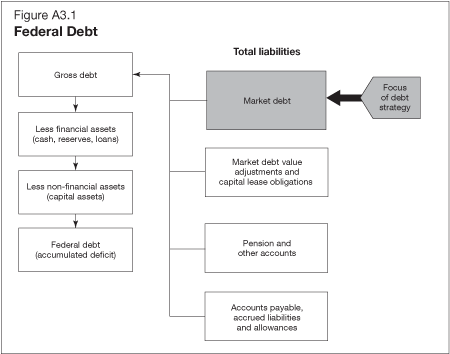
The liabilities that are actively managed under the debt strategy include wholesale and retail debt denominated in Canadian dollars, together with foreign currency liabilities. The latter category includes both direct foreign currency debt and derivatives (where domestic debt issues are converted to foreign currency via cross-currency swaps). Borrowing activities support the ongoing refinancing of government debt coming to maturity, the execution of the budget plan, and other financial operations of the Government, including investments in financial assets needed to establish a prudent liquidity position. (Table A3.1).
Table A3.1Composition of Domestic and Foreign Liabilities and Liquid Financial Assets (Forecast at March 31, 2007)
| (per cent) | |
|---|---|
| Canadian-Dollar-Denominated Liabilities 1 | |
| Marketable bonds | 63 |
| Treasury bills and cash management bills | 33 |
| Retail debt (Canada Savings Bonds and | |
| Canada Premium Bonds) | 4 |
| Canada Pension Plan bonds | – |
| Total | 100 |
| Foreign Currency Liabilities | |
| Cross-currency swaps | 75 |
| Global bonds | 15 |
| Other debt | 10 |
| Total | 100 |
| Liquid Financial Assets | |
| Cash balances | 30 |
| Foreign exchange reserves | 70 |
| Total | 100 |
Borrowing Authority
Authority to borrow in financial markets is provided by Part IV of the Financial Administration Act (FAA), which authorizes the Minister of Finance to issue securities and undertake related activities, including entering into financial contracts and derivatives transactions. Under the FAA, the Government has standing authority to refinance its market debt, and specific authority must be obtained from Parliament to undertake additional borrowing beyond an existing $4 billion of non-lapsing borrowing authority.
Under the FAA, the Minister of Finance is required to annually table in Parliament a report on the plan for managing the public debt for the upcoming fiscal year (the Debt Management Strategy) and a separate report on actual results for the fiscal year recently ended (the Debt Management Report).
The Government proposes to amend the FAA to provide greater transparency and accountability regarding the Government’s borrowing activities and increase flexibility to meet future borrowing needs, particularly with respect to the consolidation of Crown borrowings (see the section "Borrowing by Major Crown Corporations"). The proposal establishes enhanced disclosure requirements through the Debt Management Strategy on anticipated borrowing and planned uses of funds. In addition, information on actual borrowing and uses of funds compared to that forecast would be provided in the Debt Management Report. More detailed information on outcomes would also be included in the Public Accounts, where it would be subject to review by the Auditor General of Canada. With this enhanced transparency and accountability, the Government proposes removing the existing statutory limit on borrowing. Added flexibility will facilitate more efficient, responsive and prudent financial management.
Borrowing Needs
Refinancing
Federal borrowing in financial markets is driven primarily by the need to refinance debt coming to maturity during the year. There is also a need to refinance Canada Savings Bonds being redeemed by investors. In 2007–08, it is estimated that $184 billion of Government of Canada debt will need to be refinanced, the majority of which are treasury bills (Table A3.2).
Financial Source/Requirement
The other main determinant of borrowing needs is the Government’s financial source or requirement. If the Government has a financial source, it can use the source for some of its refinancing needs. If it has a financial requirement, then it must meet that requirement along with its refinancing needs.
The financial source/requirement measures the difference between cash coming in to the Government and cash going out. This measure is affected not only by the budgetary balance but also by the Government’s non-budgetary transactions. The budgetary balance is presented on a full accrual basis of accounting, recording government liabilities and assets when they are incurred or acquired, regardless of when the cash is paid or received. Non-budgetary transactions include changes in federal employee pension accounts; changes in non-financial assets; investing activities through loans, investments and advances; and other transactions (e.g. changes in other financial assets and liabilities and foreign exchange activities). Non-budgetary transactions also include adjustments made to convert the Government’s financial statements from full accrual to cash accounting.
For 2007–08, a budget surplus of $3 billion and a financial requirement of $4.7 billion are projected. Details of the forecast financial requirement can be found in Chapter 7. Actual results for the year may differ from the forecast due to uncertainty associated with economic and fiscal projections, the timing of cash transactions and other factors.
| Table A3.2 Forecast Uses of Borrowing for 2007–08 |
|
| (billions of dollars) | |
|---|---|
| Refinancing Needs | |
| Domestic debt | |
| Bonds | 35 |
| Treasury bills | 138 |
| Retail debt | 4 |
| Foreign currency debt | |
| Bonds, notes and short-term debt | 7 |
| Total refinancing needs | 184 |
| Financial Requirement 1 | |
| Budgetary surplus (financial source) | -3 |
| Non-budgetary transactions | |
| Pensions and other accounts | -4 |
| Non-financial assets | 1 |
| Loans, investments and advances | 3 |
| Of which: | |
| Loans to Crown corporations2 | 0 |
| Other transactions | 8 |
| Total financial requirement | 5 |
| Total Forecast Borrowing Needs in 2007–08 | 189 |
| Note: Totals may not add due to rounding. 1 A negative sign denotes a financial source. 2 The information presented in this document is based on the assumption that only a negligible amount of government lending to Crown corporations will be carried out in 2007–08. |
|
2007–08 Debt Strategy
Objectives
The main objective of the federal debt strategy is to raise stable and low-cost funding to meet the operational needs of the Government. An associated objective is to maintain a well-functioning Government of Canada securities market, which helps to keep debt costs low and contributes to efficient capital markets by providing important pricing and hedging tools.
Achieving the Target Debt Structure
Achieving stable, low-cost financing involves striking a balance between expected cost and cost stability over a medium-term horizon. The strategy targets the fixed-rate share of the debt, i.e. the share of the debt that is not maturing or being repriced within a year.
In 2003, it was announced that the target for the fixed-rate share of the debt would be reduced from two-thirds to 60 per cent over the course of five years in an orderly and transparent manner to achieve debt cost savings while retaining a prudent debt structure (Chart A3.1).
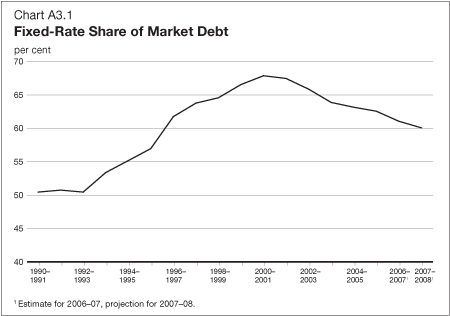
The lower fixed-rate structure modestly increases the Government’s short-term exposure to adverse movements in interest rates. Over time, however, any potential additional costs arising from a potential interest rate shock are expected to be more than offset by the ongoing debt cost savings associated with a lower fixed-rate share.
Maintaining A Well-Functioning Government Securities Market
To support a well-functioning market, the Government strives to maintain liquid, transparent, regular and diversified borrowing programs. In the prevailing environment of declining Government of Canada debt, a large number of initiatives have been taken to support the functioning of debt programs, promote competition and participation, and keep debt costs low.
A continuing challenge for the Government’s debt strategy in recent years has been to maintain sufficient issuance of Government of Canada bonds to support a liquid and efficient market. The challenge arises from the combination of declining federal borrowing needs and the decision to reduce the fixed-rate share of the debt, which has reduced the bond stock in favour of treasury bills (Chart A3.2).
Over the past 10 years, net annual bond issuance has fallen by 60 per cent, from a peak of $56 billion in 1996–97 to $23.5 billion in 2006–07. Gross annual bond issuance has fallen only 40 per cent to $33.5 billion in 2006–07 due to the use of buybacks.
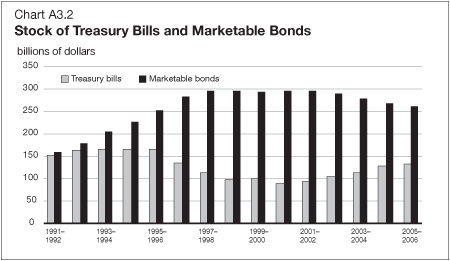
Market Consultations
As in past years, market participants were consulted as part of the process of developing the debt strategy. Views were sought on the liquidity and efficiency of the Government of Canada securities market. In addition, market participants’ views were requested on certain operational aspects of domestic debt programs.
Overall, the main messages were that the Government of Canada securities market is functioning well and adapting to an environment of declining borrowing needs. Transaction costs were said to have fallen, partly as a result of the growing use of electronic trading systems.
Given the views received, no major adjustments to debt programs or operations are considered necessary in the short run. Market participants noted a need to supplement liquidity in certain sectors, and were supportive of measures to ensure that bond issuance can be maintained over time.
More details on the subjects of discussion and the views expressed during the consultations can be found at www.bankofcanada.ca/en/notices_fmd/index.html.
Borrowing by Major Crown Corporations
Six government entities issue large amounts of debt backed by the full faith and credit of the Government of Canada. Four are Crown corporations: the Business Development Bank of Canada (BDC), Canada Mortgage and Housing Corporation (CMHC), Export Development Canada (EDC) and Farm Credit Canada (FCC). The other two are large guaranteed entities: the Canadian Wheat Board (CWB) and the Canada Housing Trust (CHT), which administers the Canada Mortgage Bond program.
All of these entities, except for EDC, require funds in Canadian dollars, and raise them through a variety of instruments, most of which bear higher interest rates than Government of Canada securities and involve payment of fees and commissions to investment dealers. The Government directly distributes its debt through an auction process, removing the additional distribution costs.
Beginning in 2008, the Government plans to meet all of the borrowing needs of BDC, CMHC and FCC through direct lending to these Crown corporations. The Government’s own debt program will be adjusted to accommodate the additional need for funds. EDC, which requires funding primarily in foreign currencies, will continue to borrow on a stand-alone basis, as will the CWB and CHT. In line with standard government practice, the Canada Mortgage Bond program is undergoing a five-year program evaluation to assess its effectiveness in achieving its objectives of improved efficiency and competitiveness of mortgage markets, increased supply of residential mortgage funds, and reduced mortgage costs for Canadian borrowers.
Under the new arrangement, outstanding BDC, CMHC and FCC debt, as well as any debt issued in 2007, will remain outstanding in the marketplace. The Minister of Finance will continue to approve all Crown borrowing plans within the context of annual corporate plan approvals. Crown corporations will remain responsible for the governance and management of treasury functions, including decisions about how much to borrow from the Government of Canada as well as asset/liability matching and the use of derivatives.
An evaluation by an external consultant, supplemented by internal analysis and consultations with market participants, indicates that replacing the Crown borrowings of BDC, CMHC and FCC with the Government of Canada’s domestic debt issuance will reduce overall borrowing costs by up to $90 million over five years.
In an environment of declining federal government borrowing, increased Government of Canada issuance resulting from consolidated borrowing will enhance the liquidity of the Government of Canada bond market. Borrowing activity by the three Crown corporations is projected to account for up to $10 billion annually in bond issuance (Chart A3.3). The consolidation of borrowing activity will not affect federal debt or total government net debt, since federal borrowing will be matched by Crown corporation assets (i.e. the Government will have additional market debt, but will have loans to Crown corporations as additional assets).
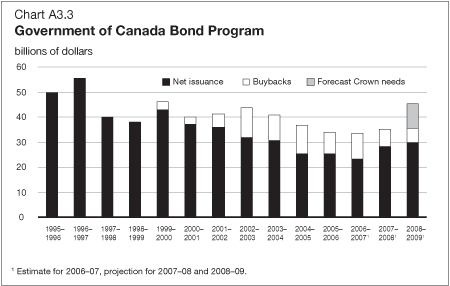
The information presented in this document assumes a negligible amount of government lending to Crown corporations in 2007–08. During the coming year, the administrative framework for consolidating borrowings will be put in place. Provided enabling legislative amendments to borrowing authority are passed during the year, consolidated activity will begin in early 2008. The implication for debt programs will be discussed in the annual debt management consultations with market participants that are planned for late in 2007. The detailed outlook for the size of the bond program and the impact on individual maturities as a result of consolidation will be set out in next year’s Debt Management Strategy.
2007–08 Debt Program
Bond Program
The size of the bond program is based on the fixed-rate target, the amount of bonds maturing, the planned market debt reduction, the plan for regular buybacks and the need for fixed-rate borrowing for other purposes, such as to fund the foreign reserves. The bond program for 2007–08 will support liquidity in the key maturities of the current bond program (i.e. 2, 5, 10 and 30 years). In 2007–08, the level of gross issuance will be increased by $1.5 billion to about $35 billion, while the total stock of bonds is planned to decline by about $2 billion to $254 billion (Table A3.3).
| Table A3.3 Bond Issuance Plan for 2007–08 (billions of dollars) |
|||
| 2005–06 | 2006–07 | 2007–08 | |
|---|---|---|---|
| Actual | Estimate | Plan | |
| Gross bond issuance | 33.9 | 33.5 | 35 |
| Buybacks | -8.6 | -10.0 | -7 |
| Net issuance | 25.3 | 23.5 | 28 |
| Maturing bonds and adjustments1 | -30.1 | -27.2 | -30 |
| Change in bond stock | -4.8 | -3.7 | -2 |
| 1 Includes cash management bond buybacks and the inflation adjustment for Real Return Bonds. | |||
Just under $1 billion of the planned $1.5-billion increase in gross issuance will be allocated to 30-year nominal and Real Return Bonds (RRBs) in recognition of high demand for long-dated securities. The increased long-term bond issuance will result in roughly equal net issuance (after regular buybacks) of nominal and indexed-linked securities, which will raise RRB issuance to slightly over $2 billion.
Gross issuance of 5-year bonds will be about $1 billion lower than last year, mostly due to a reduction in switch buyback operations. Target benchmark size will be attained because of large outstanding fungible bonds "rolling down" into that maturity range. Conversely, gross issuance of 2-year bonds, for which fungibility is also a factor, will be increased by a little over $1 billion to address liquidity concerns raised by market participants during consultations.
Benchmark Bond Targets
In 2007–08, the 2-, 5-, 10- and 30-year benchmark target sizes for bond issues that are not fungible with existing benchmarks will be maintained:
- 2-year bonds: $7 billion to $10 billion.
- 5-year bonds: $9 billion to $12 billion.
- 10-year bonds: $10 billion to $14 billion.
- 30-year bonds: $12 billion to $15 billion.
Bond Auction Schedule
Quarterly auctions of 2-, 5- and 10-year bonds and semi-annual auctions of 30-year bonds will continue, with quarterly auction calendars issued by the Bank of Canada and posted on its website before the start of each quarter. In view of the increase in RRB issuance, market participants will be consulted with respect to the profile of the auctions.
As in 2006–07, one 2-year and one 5-year auction that are fungible with outstanding bonds will be forgone. The forgone 5-year auction will be in the third quarter while the forgone 2-year auction will be in the fourth quarter (Table A3.4).
| Table A3.4 Bond Auctions by Quarter |
|||
| Fiscal Year 2006–07 | |||
|---|---|---|---|
| Q1 | Q2 | Q3 | Q4 |
| 2-year | 2-year | 2-year | – |
| 5-year | 5-year | 5-year | – |
| 10-year | 10-year | 10-year | 10-year |
| – | 30-year | – | 30-year |
|
Table A3.4 Bond Auctions by Quarter (cont'd) |
|||
| Fiscal Year 2007–08 | |||
|---|---|---|---|
| Q1 | Q2 | Q3 | Q4 |
| 2-year | 2-year | 2-year | – |
| 5-year | 5-year | – | 5-year |
| 10-year | 10-year | 10-year | 10-year |
| – | 30-year | – | 30-year |
Bond Buyback Programs
Two types of bond buyback operations will continue to be conducted: regular bond buybacks and cash management bond buybacks. Regular bond buybacks permit the maintenance of a liquid new bond issue program by buying existing bonds with a remaining term to maturity from 18 months to 25 years. Cash management bond buybacks aid in the management of cash balances by repurchasing bonds maturing within the next 18 months.
Regular Bond Buyback Operations
The size of the regular bond buyback program will be scaled back. A reduction in buybacks is appropriate as the bond stock becomes concentrated in fewer old benchmark bonds, which remain of value to market participants. While buybacks have helped support the maintenance of gross bond issuance, the need for buybacks will diminish with the decision to consolidate the borrowings of some of the Crown corporations.
The target for 2007–08 is to conduct between $7 billion and $8 billion in regular bond buyback operations, $2 billion to $3 billion less than in 2006–07. The quarterly maximum repurchase target amounts for the regular bond buyback program and the date of each operation will be announced through the quarterly bond auction calendar published by the Bank of Canada.
Cash Management Bond Buyback Operations
The cash management bond buyback program helps manage the Government’s cash requirements by reducing the high levels of cash balances needed ahead of large bond maturities. No major change is planned to cash management bond buyback operations in 2007–08.
Treasury Bill Program
By the end of 2007–08, the treasury bill stock is projected to reach an estimated level of $138 billion, about $3 billion more than at the end of 2006–07. The Government plans to continue issuing 3-, 6- and 12-month maturities.
Cash management bills (CMBs) (i.e. short-dated treasury bills) help the Government manage its cash requirements in an efficient manner. The Government intends to continue to actively use CMBs in 2007–08. In response to suggestions made by market participants, the release of the call for tenders for CMBs will be advanced from 10:00 a.m. to 9:45 a.m. Eastern Time. This is expected to promote participation, as it will no longer coincide with the release of some key economic indicators.
Retail Debt Program
As announced by the Government in September 2006, retail debt program administration is being integrated into the Department of Finance/Bank of Canada debt management governance framework. The objective for 2007–08 is to maintain current products (Canada Savings Bonds and Canada Premium Bonds), market positioning and investor service levels, while reducing administrative costs.
Further information on the retail debt program and a report on 2005–06 activities are available at www.csb.gc.ca.
Foreign Currency Funding
The Government’s foreign currency reserves are financed through foreign currency liabilities to minimize exposure to currency risk. The purpose of the Exchange Fund Account (EFA) is to aid in the control and protection of the external value of the Canadian dollar. Assets held in the EFA are managed to provide foreign currency liquidity to the Government and to promote orderly conditions for the Canadian dollar in the foreign exchange markets, if required.
The Government has access to a range of direct sources of funding for its foreign currency assets. These include a short-term US-dollar paper program, medium-term note issuance in various markets, international bond issues, and short-term purchases and sales of US dollars in foreign exchange markets. Cross-currency swaps, which are derivatives that involve exchanging domestic liabilities for US-dollar and euro-denominated liabilities, have proven to be a cost-effective alternative to issuing government debt in foreign currencies and have been actively used in recent years. They now represent 75 per cent of foreign currency liabilities.
In 2007–08, the mix of funding sources will depend on a number of considerations, including relative cost, market conditions, and the objective of maintaining a prudent foreign-currency-denominated debt maturity structure. It is expected that cross-currency swaps of domestic obligations will continue to be the primary source of reserves funding (Chart A3.4).
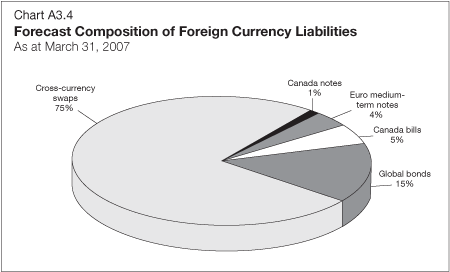
Table of Contents - Previous - Next -
